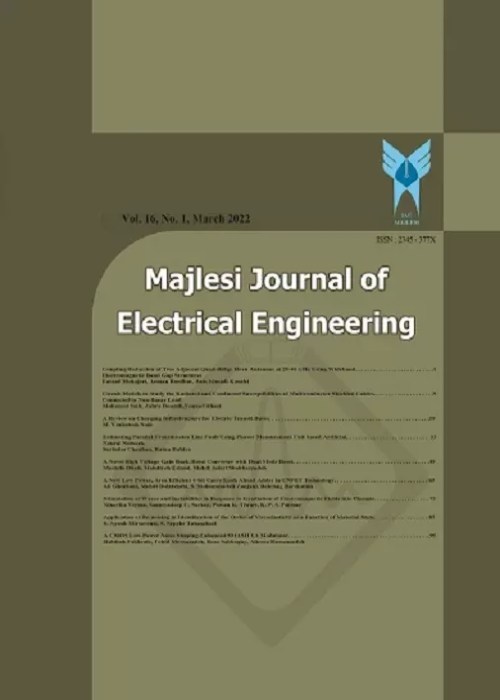فهرست مطالب
Majlesi Journal of Electrical Engineering
Volume:3 Issue: 4, 2010
- تاریخ انتشار: 1388/12/25
- تعداد عناوین: 8
-
Page 1Considering the wide usage of induction motors in various industries and the limitation of applying speed sensors in some cases, sensorless drives have became very important and the challenge to increase the accuracy of estimation continues. This paper presents a novel method for sensorless speed control for IM's that not only improve the estimation and speed tracking in DTC but also eliminate the speed sensor in DTC. For this purpose all needed parameters for sensorless speed control such as stator flux, speed and load torque are estimated with the extended Kalman filter. In this method, noise due to system structure, voltage, and current sampling is eliminated in all the effective parameters. Simulation results show the increase in the precision of estimation and speed tracking.
-
Page 11This paper presents an algorithm for the segmentation of Blood Vessels from x-ray angiography of coronary artery images using Matched filters and Otsu thresholding. Identifying these arteries is a difficult process because of the vessel overlapping, and superimposition with various anatomical structures such as the ribs, the spine and the heart chambers. Firstly, the 3D Fourier and 2D Wavelet transforms are first used to eliminate the background and reduce noise in the images. Afterwards, a set of matched filters was applied to enhance the coronary arteries in the images. Finally with Otsu thresholding and 8-connected neighborhood pixels the segmented vessel was obtained.
-
Page 21In this paper the power flow control at power systems in the presence of distributed generation is analyzed. The work proposes use of Unified power flow controller (UPFC) to control the power flow at the load bus by Main supply in coordination with DG source. This work shows that using UPFC leads to the reduction of the oscillation power and voltage at the time of three phase fault in the system. The studies are performed based on the well known software, MATLAB/SIMULINK Simulation results show that the stability and effectiveness of the applied operation of DG source in coordination with the main utility can be achieved by using UPFC.
-
Page 29This paper offers a design procedure for robust stability, robust H-infinity control and robust H2 control via dynamic output feedback for a class of uncertain linear systems. The uncertainties are of norm bounded type. Then in order to support a high-speed energy storage flywheel, these procedures are applied to an active radial magnetic bearing system. The state space matrices of this controller are the solution of some linear matrix inequalities (LMIs).
-
Page 37This paper presents the mechanical design and transient thermal analysis of a permanent magnet Brushless DC motor to be replaced with an induction motor and its gearbox for a propulsion application requiring 300 W and 220 RPM. This work presents a suitable method for direct motor drive design. The critical design criterion is based on magnet demagnetization. The motor has magnets inset into the surface of the rotor to give a maximum field-weakening range. A prototype model is fabricated based on the presented method. Analytically based lumped circuit method for thermal analysis has been used to simulate the motor. Simulation results are compared with practical measurements. The comparison of the results shows that the presented method has a high efficiency in design and thermal analysis of BLDC motors.
-
Market Estimation of the Telecom Network's Equipments Based on Cobb-Douglas Demand Forecasting ModelPage 47The goal of this paper is to estimate the capital investment in telecom network's equipments, by using Cobb-Douglas model to predict the number of subscribers for the next years of Iran. By presenting a master plan for "fixed telephony", "mobile telephony", "data", "transmission", and "access" networks, the required equipments and also the capital investment amounts are estimated. Because of the importance of operation's support systems (OSS) in the next generation networks (NGN), the amount of required capital investment for deployment of network management systems (NMS) and customer care and billing systems (CCBS), as main parts of OSS, are calculated for the next three years in this paper. To reach these estimates, the total number of subscribers in the mentioned networks is forecasted for the period 1387-90. This assessment shows an approximate investment of M7017$ for the five mentioned networks, as the total telecom equipment's market in the country. The required investment for OSS is estimated to be M688$ in the same period. An approximate investment of M399$ and M289$ is needed for NMS and CCBS, respectively.
-
Page 63In this paper, the self-heating effects (SHE) in 45nm Silicon-on-Insulator (SOI) and Silicon-on-Diamond (SOD) are investigated. As a result of the high thermal conductivity of diamond, SHE is much less pronounced in SOD structures. This makes SOD transistors suitable for high power applications were large power density is required. Our hydrodynamic simulation results show that in SOD substrate the generated heat in active transistors not only spreads away in the substrate but also is transferred to the auxiliary non-active transistors on the same die through the diamond film. Simulation results showed up to 8 times more off-current in auxiliary transistors than SOI substrate. The thermal coupling between the neighboring devices in SOD structures represent increased power consumption and device miss-match in analog circuits were high degree of matching is required.
-
Page 69In this paper a new implementation of CMOS ripple comparator cell using the Gate-Diffusion Input (GDI) technique is presented. The proposed design using this technique allows for the reduction of power consumption, propagation delay, and the area of digital circuits while maintaining low complexity of logical design. The performance comparison with standard CMOS and GDI logic design techniques is presented. These methods are compared with respect to the number of devices, PDP, and power dissipation. Simulation results confirm that the proposed cell can work at low supply voltage and dissipates low power.


